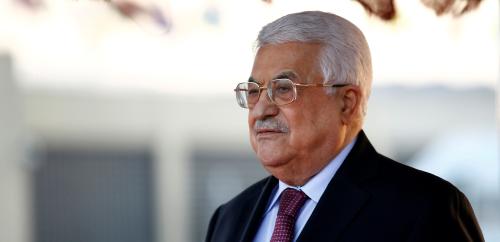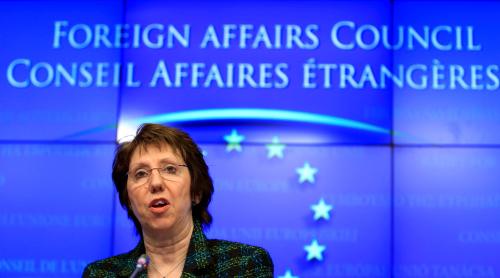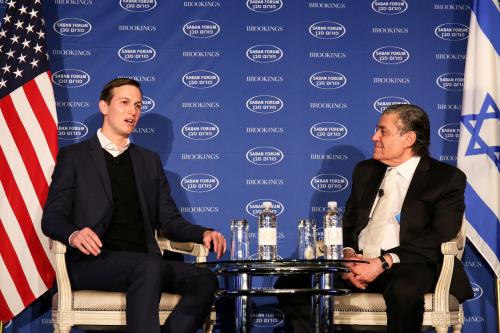Much has been written about Secretary of State John Kerry’s parting remarks on the Israeli-Palestinian conflict. But while most of the analysis has focused on whether the speech was too harsh on Israel or how well Kerry defended the U.S. abstention in the United Nations, one theme of the speech has been overlooked: the idea that the two-state solution’s cause of death is not likely to be settlements or incitement, but rather the total lack of trust between Israelis and Palestinians. As Kerry said:
“In the end, I believe the negotiations did not fail because the gaps were too wide, but because the level of trust was too low. Both sides were concerned that any concessions would not be reciprocated and would come at too great a political cost. And the deep public skepticism only made it more difficult for them to be able to take risks.”
That line is important for multiple reasons. First, it underscores that the belief gap between the Israeli and Palestinian leadership today is so wide that even if they agree completely on all of the final status issues—borders, Jerusalem, refugees, security arrangements—they are incapable of making a deal. Second, the leaders on both sides will never take the necessary risks for an agreement without overwhelming public support. That is, while public trust and support may not be a sufficient condition for a just and lasting peace, it is a necessary one. And third, the innovation that is needed to get to a deal is not finding ever-new bridging formulas on the final status issues, of which the Kerry principles are just the latest iteration, but rather a focus on how to start traversing the incredulity gap that divides the people.
[W]hile public trust and support may not be a sufficient condition for a just and lasting peace, it is a necessary one.
Mind the gap
Secretary Kerry is correct that nothing expands the belief gap more than continued settlement building on the Israeli side and glorification of violence on the Palestinian side. The crux of the quest for peace has been the concept of land for peace, and both parties seem incapable of giving the other side what they need to believe. Israelis may talk a good game, but Netanyahu’s statements about his willingness to negotiate land fall on deaf ears while settlement outposts continue to grow. The Palestinian security cooperation might keep the worst of the violence off the streets of Israel, but no level of coordination will be enough while stabbers and shooters of Israeli civilians are lionized by Fatah and monuments are dedicated to them.
Building trust between the populations requires different strategies than those for building track-one negotiations. It requires a systematic outreach approach to civil society, both in attention and, when appropriate, funding. At best, the U.S. government, alongside the other interested nations, aided civil society work in episodic bursts. At worst, they saw it as irrelevant while negotiations were ongoing.
We have both worked for years—one of us within the U.S. government, the other with Israeli, Palestinian, and American NGOs—to make the case that any peace process will fail without public support. Thus, we agree with Kerry’s comments that focusing solely on the Israeli and Palestinian leadership and ignoring the people will only perpetuate this situation of total distrust. Yet it is frustrating that it took Kerry four years to understand this point.
To be clear, the civil society track is an “and” rather than an “or.” It buttresses other strategies and enables their successes, rather than stands alone. While it is not sufficient, it is necessary for any initiative to be successful.
Unlike settlements and incitement, which are driven far more by Israeli and Palestinian domestic considerations than international policy, engagement with the Israeli and Palestinian publics is one area where the U.S. negotiating team could have played a positive and effective role. Had Secretary Kerry realized in 2012 the importance of encouraging the public to push their leaders to stay at the negotiating table, he would have likely invested more time and money in supporting the efforts of civil society groups dedicated to preserving the two-state solution. Instead, the State Department largely ignored civil society, remaining laser-focused on the top leaders.
There is one important exception to this point. The U.S. government has repeatedly and strongly defended Israeli civil society in the face of an increasing attack by the Israeli government. During Kerry’s tenure as secretary, the United States forcefully pushed back against different iterations of a harsh NGO law that particularly targeted foreign funding of human rights organizations.
However, during the 2013-2014 negotiations, Kerry made over three dozen trips to Israel and the West Bank. Yet despite the millions of miles flown and the tremendous amount of time that the secretary spent in the region, he never found a moment to meet with civil society. These were the groups, the people, whose expectations were raised when President Obama said in his 2013 speech in Jerusalem:
“And let me say this as a politician—I can promise you this, political leaders will never take risks if the people do not push them to take some risks. You must create the change that you want to see. Ordinary people can accomplish extraordinary things.”
Civil societies were expected to market the negotiations to their skeptical people, knowing that their governments were pouring cold water on them. Throughout the 14 months of negotiations, no senior member of the negotiating team held a town hall or public meeting with those who were expected to sell the process—either to hear their concerns or to give them the necessary boost to build domestic support for their efforts. And while there were some private attempts at outreach to civil society, they were insufficient and lacked the necessary high-level support to move the dial. When even the negotiators don’t take the efforts of those supporting them seriously, it is hard for them to be taken seriously within their own societies and by their own leadership.
Throughout the Obama administration, the U.S. Agency for International Development (USAID) provided $10 million a year in funding reconciliation programs between Arabs and Jews, Israelis and Palestinians. Not once did this line item make it into the Obama administration’s budget. Each year it was added to the federal budget after considerable effort on the congressional level in an ever-more difficult fiscal environment. When compared to how much the United States spends on military assistance to Israel and paying down the debts of the Palestinian Authority, it is a fraction of the resource to something that the administration only now recognizes as the underlying foundation to move forward.
Ball in Trump’s court
The next administration, whose dedication to the two-state solution is questionable, might look for some out-of-the-box ideas to try and unstick the parties and move the situation to a more stable setting. If we have any advice for them it is this, it starts with hope and change. It might seem odd that the Obama slogan needs to the be organizing philosophy for their approach to the Israeli Palestinian conflict, but without hope, the parties will never move beyond their retrenchment. The key to hope is change, that the status quo can be different, that people do have agency.
To help each society recognize this potential, all the tools in the foreign policy toolkit must be used, including working with civil society groups. That’s essential for delivering that message and demonstrating to skeptical people that we are in a new era with new opportunities.
This should include:
- Senior level advisors, including the new advisor for International Negotiations Jason Greenblatt, meeting with not just the parties, but civil society groups privately as well publically;
- Inclusion of the USAID people-to-people reconciliation grant program into the federal budget; and
- Leveraging U.S. dollars off those of the rest of the international community in the creation of an International Fund for Israeli-Palestinian Peace, which currently enjoys bipartisan support, that can provide the necessary bandwidth and budget for a systemic approach to the trust deficit.
We are glad Secretary Kerry understands how important it is to establish trust and confidence among the leaders in order to preserving the two-state solution. And we are glad he made a strong case for why the Israeli and Palestinian people must push their leaders to take political risks.
With the Paris peace conference on the horizon, a new U.S. administration being sworn in, and the parties jockeying for position in the new environment, we hope that the lessons that took four years for Secretary Kerry to learn can be remembered and reflected on as seriously as the principles that he presented.










Commentary
Is a peace deal possible if Israelis and Palestinians simply don’t trust each other?
January 3, 2017